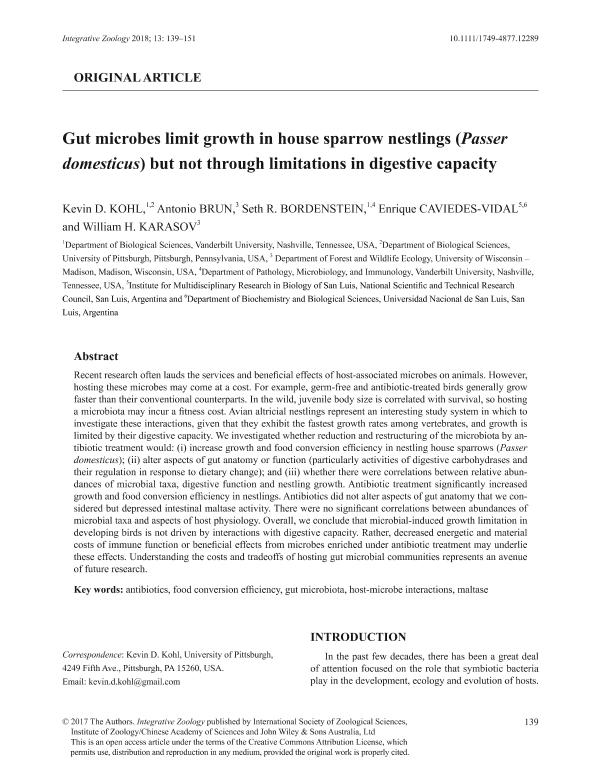Mostrar el registro sencillo del ítem
dc.contributor.author
Kohl, Kevin

dc.contributor.author
Brun, Antonio

dc.contributor.author
Bordenstein, Seth R.
dc.contributor.author
Caviedes Vidal, Enrique Juan Raul

dc.contributor.author
Karasov, William

dc.date.available
2019-11-14T21:25:28Z
dc.date.issued
2018-03
dc.identifier.citation
Kohl, Kevin; Brun, Antonio; Bordenstein, Seth R.; Caviedes Vidal, Enrique Juan Raul; Karasov, William; Gut microbes limit growth in house sparrow nestlings (Passer domesticus) but not through limitations in digestive capacity; Wiley Blackwell Publishing, Inc; Integrative Zoology; 13; 2; 3-2018; 139-151
dc.identifier.issn
1749-4877
dc.identifier.uri
http://hdl.handle.net/11336/88995
dc.description.abstract
Recent research often lauds the services and beneficial effects of host-associated microbes on animals. However, hosting these microbes may come at a cost. For example, germ-free and antibiotic-treated birds generally grow faster than their conventional counterparts. In the wild, juvenile body size is correlated with survival, so hosting a microbiota may incur a fitness cost. Avian altricial nestlings represent an interesting study system in which to investigate these interactions, given that they exhibit the fastest growth rates among vertebrates, and growth is limited by their digestive capacity. We investigated whether reduction and restructuring of the microbiota by antibiotic treatment would: (i) increase growth and food conversion efficiency in nestling house sparrows (Passer domesticus); (ii) alter aspects of gut anatomy or function (particularly activities of digestive carbohydrases and their regulation in response to dietary change); and (iii) whether there were correlations between relative abundances of microbial taxa, digestive function and nestling growth. Antibiotic treatment significantly increased growth and food conversion efficiency in nestlings. Antibiotics did not alter aspects of gut anatomy that we considered but depressed intestinal maltase activity. There were no significant correlations between abundances of microbial taxa and aspects of host physiology. Overall, we conclude that microbial-induced growth limitation in developing birds is not driven by interactions with digestive capacity. Rather, decreased energetic and material costs of immune function or beneficial effects from microbes enriched under antibiotic treatment may underlie these effects. Understanding the costs and tradeoffs of hosting gut microbial communities represents an avenue of future research.
dc.format
application/pdf
dc.language.iso
eng
dc.publisher
Wiley Blackwell Publishing, Inc

dc.rights
info:eu-repo/semantics/openAccess
dc.rights.uri
https://creativecommons.org/licenses/by-nc-sa/2.5/ar/
dc.subject
ANTIBIOTICS
dc.subject
FOOD CONVERSION EFFICIENCY
dc.subject
GUT MICROBIOTA
dc.subject
HOST-MICROBE INTERACTIONS
dc.subject
MALTASE
dc.subject.classification
Zoología, Ornitología, Entomología, Etología

dc.subject.classification
Ciencias Biológicas

dc.subject.classification
CIENCIAS NATURALES Y EXACTAS

dc.subject.classification
Biología Celular, Microbiología

dc.subject.classification
Ciencias Biológicas

dc.subject.classification
CIENCIAS NATURALES Y EXACTAS

dc.title
Gut microbes limit growth in house sparrow nestlings (Passer domesticus) but not through limitations in digestive capacity
dc.type
info:eu-repo/semantics/article
dc.type
info:ar-repo/semantics/artículo
dc.type
info:eu-repo/semantics/publishedVersion
dc.date.updated
2019-10-02T19:43:47Z
dc.journal.volume
13
dc.journal.number
2
dc.journal.pagination
139-151
dc.journal.pais
Estados Unidos

dc.description.fil
Fil: Kohl, Kevin. Vanderbilt University; Estados Unidos. University of Pittsburgh; Estados Unidos
dc.description.fil
Fil: Brun, Antonio. Consejo Nacional de Investigaciones Científicas y Técnicas; Argentina. University of Wisconsin; Estados Unidos
dc.description.fil
Fil: Bordenstein, Seth R.. Vanderbilt University; Estados Unidos
dc.description.fil
Fil: Caviedes Vidal, Enrique Juan Raul. Consejo Nacional de Investigaciones Científicas y Técnicas. Centro Científico Tecnológico Conicet - San Luis. Instituto Multidisciplinario de Investigaciones Biológicas de San Luis. Universidad Nacional de San Luis. Facultad de Ciencias Físico Matemáticas y Naturales. Instituto Multidisciplinario de Investigaciones Biológicas de San Luis; Argentina
dc.description.fil
Fil: Karasov, William. University of Wisconsin; Estados Unidos
dc.journal.title
Integrative Zoology
dc.relation.alternativeid
info:eu-repo/semantics/altIdentifier/doi/https://doi.org/10.1111/1749-4877.12289
dc.relation.alternativeid
info:eu-repo/semantics/altIdentifier/url/http://europepmc.org/backend/ptpmcrender.fcgi?accid=PMC5873389&blobtype=pdf
dc.relation.alternativeid
info:eu-repo/semantics/altIdentifier/url/https://onlinelibrary.wiley.com/doi/full/10.1111/1749-4877.12289
dc.relation.alternativeid
info:eu-repo/semantics/altIdentifier/url/https://www.ncbi.nlm.nih.gov/pmc/articles/PMC5873389/
Archivos asociados
